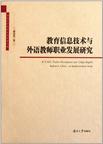教育信息技术与外语教师职业发展研究
出版时间:2011-11 出版社:湖南大学出版社 作者:胡志雯 页数:286
Tag标签:无
内容概要
《教育信息技术与外语教师职业发展研究》以大学英语改革为背景,探讨新形势下大学外语教师的职业培训和发展现状是否能满足改革的要求(特别是将现代教育信息技术与课程相结合)及教师终生职业发展的需求。同时论证了教育信息技术既可以作为教师教育的内容来提升英语教师的信息素养,又可以作为教师教育和发展的有效手段使教师教育和发展具有可持续性、协作性和终身性。
作者简介
胡志雯,女,1972年2月生,副教授,英国诺丁汉大学博士,湖南大学外国语与国际教育学院语言学及应用语言学专业硕士生导师。湖南省普通高校青年骨干教师培养对象,湖南大学优秀教师。主要研究领域:教师教育与发展、教育信息技术在外语中的应用、外语教育、教育改革以及ESP(商务方向)。剑桥商务英语中级、高级证书口试和笔试考官,国家公共英语五级(PETS5)口笔试考官。历年来主持或主研各类科研和教改课题十余项,目前主持国家教育部人文社会科学研究青年基金项目l项、中央高校基本科研业务费专项资金项目及其他课题4项。主编或编写各类著作和教材17部,发表学术论文16篇,其中国际学术期刊论文2篇。获各类奖项共7项。
书籍目录
Key AcronymsChapter One Introduction1.1 Background1.2 Key Terms1.2.1 Change, Reform and Innovation1.2.2 ICT & ICTLE1.2.3 Teacher Training, Education and Development1.3 Focus of the Research1.4 Significance of the Research1.5 Structure of the BookChapter Two Educational Innovation: ICT Use and Continuing ProfessionalDevelopment2.1 Introduction2.2 Theories of Innovation/Change2.2.1 The Theory of Diffusion of Innovations2.2.2 The Theory of New Meaning of Educational Change2.2.3 The Concerns-Based Adoption Model2.3 The Implementation of ICT in Education2.3.1 The Impact of ICT2.3.2 Practice: ICT in Language Education (ICTLE)2.3.3 Factors Influencing Implementation2.4 Continuing Professional Development for ICT2.4.1 The Role of ICT in Teacher Development2.4.2 Elements of CPD2.4.3 Models for CPD2.4.4 ICT-Related CPD for Language Teachers2.5 Conclusion.2.5.1 Review2.5.2 Conceptual FrameworkChapter Three The Chinese Context: College English Reform and EFLTeacher Development3.1 Introduction3.2 English Teaching & Learning in Chinese Higher Education3.2.1 Chinese Higher Education3.2.2 English Language Teaching and Learning3.2.3 ELT Pedagogy in Higher Education3.3 The College English Reform3.3.1 Materials3.3.2 ICT Pedagogy3.3.3 Evaluation3.3.4 Course Design and Administration3.4 EFL Teacher Development in China3.4.1 A Brief Summary of Teacher Development in China3.4.2 EFL Teachers' Professional Development3.4.3 EFL Teacher Development for ICT3.5 ConclusionChapter Four Research Methodology4.1 Introduction4.2 Research Design4.2.1 Why Mixed Methods4.2.2 Why a Case Study4.3 Selection of Case Study Site4.4 Selection of Participants4.4.1 The Questionnaire Sample4.4.2 The Classroom Teaching Sample4.4.3 The Management and Administrative Staff Sample4.4.4 The Student Sample4.5 Methods Design……Chapter Five Data Analysis and DiscussionChapter Six ConclusionsAppendix 1Appendix 2Appendix 3Appendix 4Appendix 5Appendix 6References
章节摘录
EFL teachers also serve as teaching administrators and this role has become more and more important in the computer-and classroom-based new teaching model (see Figure 3. 2, discussed earlier). Teachers should make efforts to guide and tutor students in their learning process, particularly in computer rooms where individual centred, autonomous learning is highlighted. Figure 3.2 shows that teachers, and not just the administrative department, can also manage the classroom with the help of teaching management software. This software enables teachers to record students academic scores and learning progress in computer-and Web-based autonomous learning systems, answer students' questions, solve their problems on the spot and analyse exam papers; and enhances teachers' communication with students via a Web assistant platform in terms of online problem-solving for students, course selecting, submitting and commenting assignments. The figure indicates a required role-shift from instructor to teaching organiser and administrator. A specific College English Curriculum and teaching objectives guidelines for teaching in each college and university are normally designed by an administrative department, such as the Administrative Office of Teaching Affairs, within the college or university. As discussed above, the computer-and Web-based English teaching and learning model aims to mobilise the initiative of both teachers and students and highlights the centrality of students and the guiding role of teachers. The Requirements also suggest that the new model should incorporate the advantages of the traditional classroom teaching model while fully exploiting ICT (MOE, 2007). This kind of change necessitates that teachers' classroom practice, professional and pedagogical knowledge, and professional learning must all under-go significant transformation. ……
图书封面
图书标签Tags
无
评论、评分、阅读与下载
